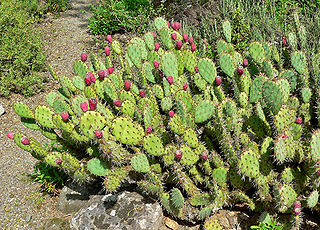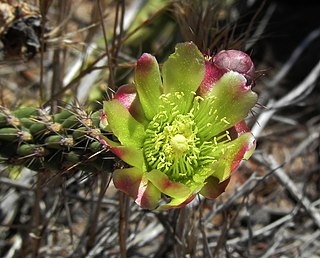
Cylindropuntia fulgida, the jumping cholla, also known as the hanging chain cholla, is a cholla cactus native to Sonora and the Southwestern United States.

Cylindropuntia bigelovii, the teddy-bear cholla, is a cholla cactus species native to Northwestern Mexico, and to the United States in California, Arizona, and Nevada.

Cylindropuntia imbricata, the cane cholla, is a cactus found in the Southwestern United States and northern Mexico, including some cooler regions in comparison to many other cacti. It occurs primarily in the arid regions of the Southwestern United States in the states of Kansas, Oklahoma, Texas, New Mexico, Arizona, Colorado, and Nevada. It is often conspicuous because of its shrubby or even tree-like size, its silhouette, and its long-lasting yellowish fruits.

In 1984, the International Organization for Succulent Plant Study set up a working party, now called the International Cactaceae Systematics Group, to produce a consensus classification of the cactus family, down to the level of genus. Their classification has been used as the basis for systems published since the mid-1990s. Treatments in the 21st century have generally divided the family into around 125–130 genera and 1,400–1,500 species, which are then arranged in a number of tribes and subfamilies. However, subsequent molecular phylogenetic studies have shown that a very high proportion of the higher taxa are not monophyletic, i.e. they do not contain all of the descendants of a common ancestor. As of August 2023, the internal classification of the family Cactaceae remained uncertain and subject to change. A classification incorporating many of the insights from the molecular studies was produced by Nyffeler and Eggli in 2010.

Cylindropuntia is a genus of cacti, containing species commonly known as chollas, native to northern Mexico and the Southwestern United States. They are known for their barbed spines that tenaciously attach to skin, fur, and clothing. Stands of cholla are called cholla gardens. Individuals within these colonies often exhibit the same DNA, as they were formerly tubercles of an original plant.

Lomatium is a genus in the family Apiaceae. It consists of about 100 species native to western Northern America and northern Mexico. Its common names include biscuitroot, Indian parsley, and desert parsley. It is in the family Apiaceae and therefore related to many familiar edible species such as carrots and celery; some Lomatium species are extensively used by Native Americans in the inland Northwest as a staple food.

Cylindropuntia acanthocarpa, commonly referred to as buckhorn cholla, is a cholla native to the Mojave, Sonoran, and Colorado Deserts of North America. Along with Cylindropuntia bigelovii, it is the most common cholla found in these deserts.

Cymopterus is a genus of perennial plants in the family Apiaceae native to western North America. They are commonly known as the spring parsleys. They are mostly stemless, taprooted perennial herbs with leaves at ground level and flowering scapes bearing yellow, white, or purple flowers.

Perityle is a genus of flowering plants in the daisy family. They are known generally as rock daisies.

Opuntia, commonly called the prickly pear cactus, is a genus of flowering plants in the cactus family Cactaceae, many known for their flavorful fruit and showy flowers. Prickly pear alone is more commonly used to refer exclusively to the fruit, but may also be used for the plant itself; in addition, other names given to the plant and its specific parts include tuna (fruit), sabra, nopal from the Nahuatl word nōpalli, nostle (fruit) from the Nahuatl word nōchtli, and paddle cactus. The genus is named for the Ancient Greek city of Opus, where, according to Theophrastus, an edible plant grew and could be propagated by rooting its leaves. The most common culinary species is the Indian fig opuntia (O. ficus-indica).

Rumfordia is a genus of Mesoamerican plants in the tribe Millerieae within the family Asteraceae.

Cylindropuntia echinocarpa is a species of cactus known by the common names silver cholla, golden cholla, and Wiggins' cholla. It was formerly named Opuntia echinocarpa.

Cylindropuntia californica is a species of cholla cactus known by the common name snake cholla. It is primarily found in Baja California, Mexico and the southernmost part of California in the United States. It is characterized by a short, decumbent habit, yellow-green flowers, elongated stems, and short spines. It is mostly found in coastal sage scrub and coastal chaparral habitats, but two varieties in Baja California can be found in foothills and deserts. In California, variety californica is regarded as a rare and threatened plant, with a California Native Plant Society listing of 1B.1, in part due to its limited number of occurrences and threats from development. It formerly was considered to have a larger range due to the inclusion of Cylindropuntia bernardina within it as the variety parkeri.

Cylindropuntia prolifera, known by the common name Coastal cholla, is a species of cactus. In Australia it is called 'Jumping Cholla' because of it seeming to jump from outbreak to outbreak.

Cylindropuntia leptocaulis, the desert Christmas cactus, desert Christmas cholla, pencil cactus, or tasajillo, is a species of cholla cactus.
Many cacti are known to be psychoactive, containing phenethylamine alkaloids such as mescaline. However, the two main ritualistic (folkloric) genera are Echinopsis, of which the most psychoactive species occur in the San Pedro cactus group, and Lophophora, with peyote being the most psychoactive species. Several other species pertaining to other genera are also psychoactive, though not always used with a ritualistic intent.

Mammillaria brandegeei is a species of cactus in the subfamily Cactoideae.
Cylindropuntia calmalliana is a species of flowering plant in the family Cactaceae, native to Mexico. It was first described in 1896 by John Merle Coulter, as Opuntia calmalliana.

Mammillaria pringlei, called the lemon ball, is a species of cactus in the genus Mammillaria, native to Mexico, from Querétaro through to Veracruz and on to México State. It has gained the Royal Horticultural Society's Award of Garden Merit.

















